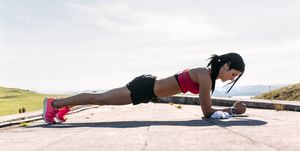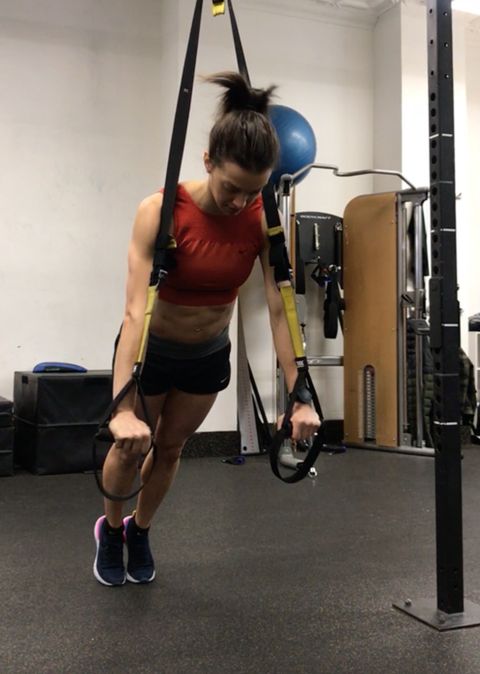
You know the obvious benefit of abs exercises: a chiseled midsection you that will make you look and feel like Britney-freaking-Spears. But aesthetics shouldn’t be the only things dictating your abdominal workout.
“Abdominals are not just there to make you look good, they’re actually part of your core, which provide stability to the spine,” says Rachel Mariotti, C.S.C.S., a personal trainer at Equinox in New York City. And spinal stability is hugely important, because that’s what keeps you standing tall and moving throughout your day without any pain or limitations.



“If you’re only focusing on the front of your abs, i.e. your six-pack—the rectus abdominis—you’re only really working 30 percent of your core,” Mariotti explains. You also need to work your internal and external obliques, and the transverse abdominis, the muscle underneath the obliques, she says.
And working your abs should be part of larger core or strength routine—a.k.a. not just busting out 500 crunches on the daily. Adding 15 to 20 minutes of abs work at the end of a strength training session two times a week will do the job, she says.
“Try adding two to three of the abs exercises below into your current legs, arms, or full-body strength routine, doing them back-to-back at the end of the workout to gain the most benefit,” suggests Mariotti. “Most of them target multiple parts of the abs and core at the same time.”
And here’s the secret when it comes to abs workouts: It’s not so much about sets and reps, and more about time under tension. “This means you want to feel a good burn in your abs and core without taking too much rest,” says Mariotti.
Soon enough, you’ll see those abs popping right out.
1. Cable Chops
How to do it: Holding a cable handle in both hands at your chest, turn sideways and step a few feet from the machine, standing with feet wider than hip-width apart. Press arms straight out from the chest. Holding there, rotate arms away from machine, keeping legs and hips stable. Return to starting position with arms extended. That’s one rep.
Recommended sets/reps: 3 sets of 12 reps with 12- to 20-pounds
What it works: The chopping motion works your obliques and transverse abdominis, plus “it teaches your body how to use core muscles during the rotation of the spine,” says Mariotti, which is important for mobility.
2. Bar Chops
How to do it: Holding a cable bar in both hands, turn sideways and step a few feet from machine, standing with feet wider than hip-width apart. Press arms straight out from the chest, holding the bar perpendicular to the body. Twist away from the machine without compensating in the shoulder or back and keeping arms locked and legs and hips stable. Return to starting position with arms extended. That’s one rep.
Recommended sets/reps: 3 sets of 12 reps with 12- to 20-pounds
What it works: In addition to your obliques and transverse abdominis, this version of the chop works the serratus anterior, a muscle along the side of your ribs under your armpit. And just like the cable chop, it works your spine mobility.
3. Angled Bar Chop
How to do it: Holding a cable bar in both hands, turn sideways and step a few feet from machine, standing with feet wider than hip-width apart. Press arms out from the waist, holding the bar at an angle to the body. Chop at an upward angle as you rotate away from the machine. Return to starting position with arms extended. That’s one rep.
Recommended sets/reps: 3 sets of 12 reps with 12- to 20-pounds
What it works: “Moving at a different angle will activate and put more tension on different parts of the abs, obliques, and core,” says Mariotti.
4. TRX Pushup
How to do it: Hold the TRX handles in a pushup position, shoulders directly over wrists. Keeping hips down and stomach tight, push arms forward until they get close to your ears. Pull them back in to return to start. That’s one rep.
Recommended sets/reps: 3 sets of 10 reps
What it works: “Using the TRX gives you less stability, making the intricate muscles of the core activate and stabilize,” says Mariotti. “This move activates the rectus abdominis while engaging several parts of the core such as the serratus anterior and lats.”
5. TRX Hold

Courtesy of Mariotti
How to do it: Hold the TRX handles in a pushup position, shoulders directly over wrists.
Recommended sets/reps: 4 sets of 1-minute holds
What it works: “Holding this position can put more tension on the abs and core helping them become stronger,” says Mariotti.
6. Hanging Knee-up
How to do it: Hang from a bar with your body in a straight line. Squeeze your abs to draw the knees up slowly, until they’re slightly above hip height. Slowly lower down while engaging the lats to avoid a swing. That’s one rep.
Recommended sets/reps: 3 sets of 15 reps
What it works: “This engages your entire rectus abdominis—your “six-pack abs”—while forcing the lats to stabilize,” says Mariotti.
7. Hanging Knee Holds
How to do it: Hang from a bar with a straight body. Squeeze abs to draw the knees up slowly until they’re slightly above hip height. Hold.
Recommended sets/reps: 4-5 sets of 20- to 30-second holds
What it works: “Holding the knees up will start to create a high amount of tension on the rectus abdominis, forcing it to become even stronger,” says Mariotti.
8. Toes to Bar
How to do it: Hang from a bar with a straight body. Use your lats, abs, and quad strength to draw your toes to the bar while keeping your arms locked. Lift toes as high as possible, then lower back down. That’s one rep. Try to avoid using momentum or swinging.
Recommended sets/reps: 4 sets of 8 reps
What it works: The amount of strength this takes seriously engages your rectus abdominis, transverse abdominis, lats, and obliques—almost your entire core.
9. L-Sits with Bent Knees
How to do it: On waist-high parallette bars, prop yourself up and draw the knees up slightly above hip height with ankles directly below knees. Hold.
Recommended sets/reps: 3-4 sets of 30- to 45-second holds
What it works: “This move is an isometric hold that will build strength in the rectus abdominis,” says Mariotti. “But you’ll also get engagement from the back, shoulders, and lats if properly engaged.”
10. L-Sits with Straight Legs
How to do it: On waist-high parallette bars, prop yourself up and draw the knees up slightly above hip height with ankles directly below knees. Straighten the legs while trying to keep the hips directly below the shoulders and the ankles from dipping below hip height. Hold.
Recommended sets/reps: 3-4 sets of 15- to 20-second holds
What it works: “Straightening your legs brings the parallette bar knee hold to the next level,” says Mariotti. “It creates higher tension in the lower abdomen because of the shifting of the center of mass, which makes it a great strength builder for your core and abs.”
11. Hollow Body Hold
How to do it: Lie with your back down on a yoga mat and stretch arms above the head. Lift the legs, arms, and shoulders up off the mat 3-6 inches while keeping lower back glued to the mat. To make it easier, simple bend the knees to shift the center of mass closer to your abdomen.
Recommended sets/reps: 3-4 sets of 45- to 60-second holds
What it works: This isometric hold is a major strengthener for your rectus abdominis and transverse abdominis.
12. Leg Lowers
How to do it: Lie flat on your back on a mat. Slide your hands slightly underneath your butt and lift legs so ankles are directly above the hips. Keeping your lower back glued to the mat, slowly lower the legs back down until they hover about three inches above the mat. Slowly bring legs back up (about 5 seconds), but don’t let the ankles go past the belly button. That’s one rep.
Recommended sets/reps: 3-4 sets of 10-15 reps
What it works: “This is a major lower abs strengthener,” says Mariotti.
13. Bicycle Crunches
How to do it: Lying flat on back, bend legs at 90 degrees, arms bent behind head. Bring opposite knee to opposite elbow. Then rotate to other side, making sure not to push your head with your hands. Continue alternating sides, keeping low back glued to mat.
Recommended sets/reps: 4 sets of 60-seconds
What it works: “These build strength in your abdomen, including the rectus abdominis, transverse abdominis, and oblique muscles,” says Mariotti.
14. Stability Ball Plank
How to do it: Place your forearms on a stability ball and extend your legs directly behind you; your body should form a straight line from head to heels. Brace your abs and hold.
Recommended sets/reps: 3-4 sets of 60-second holds
What it works: “Challenging your stability on the ball forces the intricate muscles of the core and abs to activate and stabilize the body,” says Mariotti.
15. Side Plank
How to do it: Lie on your right side with your legs straight. Prop yourself up with your right forearm so your body forms a diagonal line. Rest your left hand on your hip. Brace your abs and hold. Stagger feet if being stacked is too challenging.
Recommended sets/reps: 4 sets of 30-second holds on each side
What it works: “This is a great way to isolate and strengthen the obliques,” says Mariotti. “It also strengthens your shoulders.”
Source: Read Full Article
